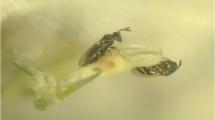Abstract
Extracts prepared from elderberry,Sambucus simpsonii Rehd., leaves with either acetone, dichloromethane, distilled water, ethanol, hexane, or methanol deterred oviposition byHeliothis virescens (F.) on treated substrates in the laboratory. Doses of the aqueous extract equivalent to as little as 0.8 mg of leaves/cm2 of oviposition substrate were effective in reducing egg deposition. There was no significant difference in the mean number of landings on extract-treated and untreated surfaces. When either the antennae, proboscis, or the metathoracic legs were removed from female moths, there was no significant effect on oviposition on paper towels treated with elderberry leaf-water extract in laboratory bioassays, but in field cages, moths without these appendages deposited significantly fewer eggs on treated leaves of tobacco plants, a preferred host. There was no evidence that elderberry leaf-water extract affected mating byH. virescens.
Similar content being viewed by others
References
Behan, M., andSchoonhoven, L.M. 1978. Chemoreception of an oviposition deterrent associated with eggs inPieris brassicae.Entomol Exp. Appl. 24:163–179.
Benz, G. 1969. Influence of mating, insemination and other factors on oogenesis and oviposition in the moth,Zeiraphera diniana.J. Insect Physiol. 15:55–71.
Boddé, T. 1982. Entomologists probe chemical defenses and natural enemies.BioScience 32:308–311.
Chadha, G.K., andRoome, R.E. 1980. Oviposition behavior and the sensilla of the ovipositor ofChilo partellus andSpodoptera littoralis (Lepidoptera: Noctuidae).J. Zool. (London) 192:169–178.
David, W.A.L., andGardiner, B.O.C. 1962. Feeding behavior of adults ofPieris brassicae (L.) in a laboratory culture.Bull. Entomol. Res. 52:741–762.
Jackson, D.M., Cheatham, J.S., Pitts, J.M., andBaumhover, A.H. 1983. Ovipositional response of tobacco budworm moths (Lepidoptera: Noctuidae) to tobacco introduction 1112 and NC 2326 in cage tests.J. Econ. Entolmol. 76:1303–1308.
Jermy, T., andSzentesi, A. 1978. The role of inhibitory stimuli in the choice of oviposition site by phytophagous insects.Entomol. Exp. Appl. 24:458–471.
Ma, W.C., andSchoonhoven, L.M. 1973. Tarsal contact chemosensory hairs of the large white butterflyPieris brassicae and their possible role in oviposition behavior.Entomol. Exp. Appl. 16:343–357.
Mitchell, E.R., andHeath, R.R. 1985. Influence ofAmaranthus hybridus L. allelochemicals on oviposition behavior ofSpodoptera exigua andS. eridania (Lepidoptera: Noctuidae).J. Chem. Ecol. 11:609–618.
Renwick, J.A.A., andRadke, C.D. 1981. Host plant constituents as oviposition deterrents for the cabbage looper.Trichoplusia ni. Entomol.Exp. Appl. 30:201–204.
Saxena, K.N., andGoyal, S. 1978. Host-plant relations of the citrus butterflyPapilio demoleus L.: Orientational and ovipositional responses.Entomol. Exp. Appl. 24:1–10.
Städler, E. 1974. Host plant stimuli affecting oviposition behavior of the eastern spruce budworm.Entomol. Exp. Appl. 17:176–178.
Städler, E. 1978. Chemoreception of host plant chemicals by ovipositing females ofDelia (Hylemya) brassicae.Entomol. Exp. Appl. 24:711–720.
Tingle, F.C., andMitchell, E.R. 1984. Aqueous extracts from indigenous plants as oviposition deterrents forHeliothis virescens (F.).J. Chem. Ecol. 10:101–113.
Valencia, L., andRice, M.J. 1982. Contact chemoreceptors on the ovipositor of the potato moth,Phthorimaea operculella (Zell.) (Lepidoptera: Gelechiidae).Int. J. Insect Morphol. Embryol. 11:121–128.
Williams, A.L., Mitchell, E.R., Heath, R.R., andBarfield, C.S. 1986. Oviposition deterrents for fall armyworm (Lepidoptera: Noctuidae) from larval frass, com leaves, and artificial diet.Environ. Entomol. 15:327–330.
Yamada, M. 1971. The dendritic action potentials in an olfactory hair of the fruit piercing moth,Oraesia excavata.J. Insect Physiol. 17:169–179.
Yamamoto, R.T., Jenkins, R.Y., andMcCluskey, R.K. 1969. Factors determining the selection of plants for oviposition by the tobacco hornworm,Manduca sexta.Entomol. Exp. Appl. 12:504–508.
Author information
Authors and Affiliations
Additional information
Lepidoptera: Noctuidae.
Mention of a commercial or proprietary product does not constitute an endorsement by the USDA.
Rights and permissions
About this article
Cite this article
Tingle, F.C., Mitchell, E.R. Behavior ofHeliothis virescens (F.) in presence of oviposition deterrents from elderberry. J Chem Ecol 12, 1523–1531 (1986). https://doi.org/10.1007/BF01012369
Received:
Accepted:
Issue Date:
DOI: https://doi.org/10.1007/BF01012369




